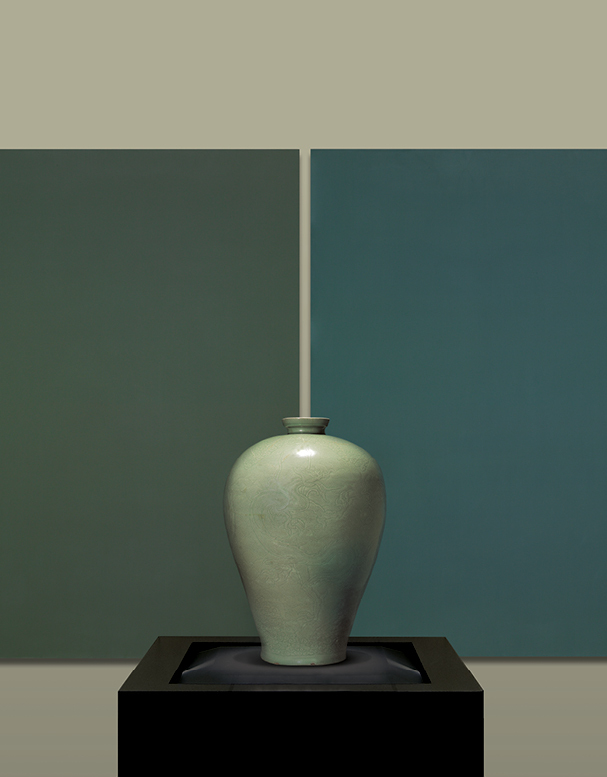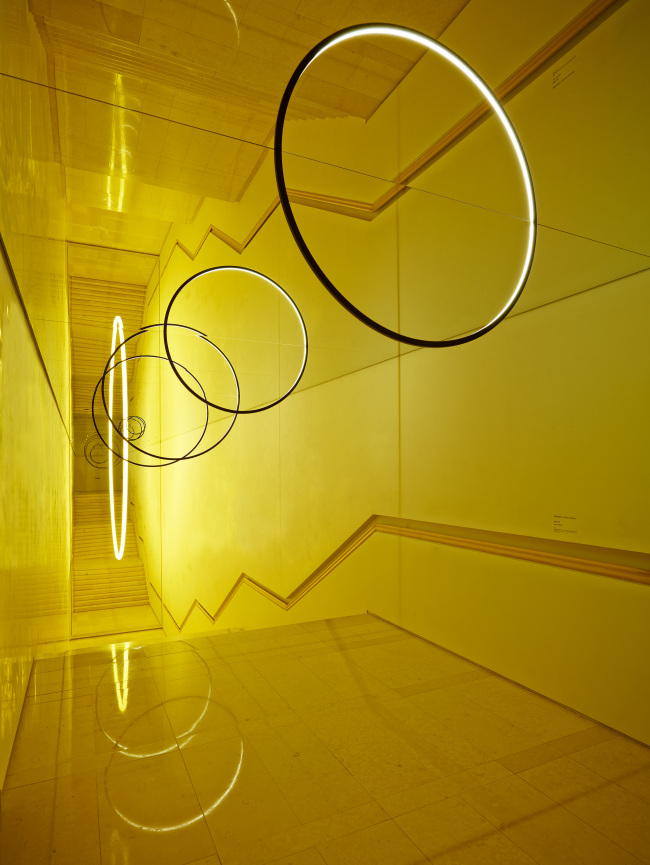Old and new, East and West pieced together
Art trove of Leeum, Samsung Museum of Art, revealed in 10th anniversary exhibition
By Lee Woo-youngPublished : Aug. 20, 2014 - 20:54
A 12th-century celadon from the Goryeo Dynasty boasts graceful curves and a delicate jade-green color. Displayed behind the celadon, two 1995-1996 paintings in different shades of celadon green by artist Byron Kim add a modern simplicity to the centuries-old artifact.
The two artworks made 800 years apart show a harmony that transcends time in the pursuit of pure elegance. The link between old and new, the East and West runs throughout the 10th anniversary exhibition of Leeum, Samsung Museum of Art, which kicked off on Tuesday.
The two artworks made 800 years apart show a harmony that transcends time in the pursuit of pure elegance. The link between old and new, the East and West runs throughout the 10th anniversary exhibition of Leeum, Samsung Museum of Art, which kicked off on Tuesday.

From priceless artifacts and eye-catching paintings, to avant-garde contemporary art, the exhibition displays diverse aspects of art that art lovers look for in an exhibition.
The museum doesn’t stop at just exhibiting the 230 works from its art trove, but seeks to connect them based on ideas, expressions and application to today’s society. The pairings of artwork transcend time and space, offering a new perspective on appreciating masterpieces from different periods.
Some of the highlights include Buddhist statues and metal works from the Three Kingdoms period (4th-7th century) and Goryeo Dynasty (918-1392) paired with Alberto Giacometti’s skeleton-like sculpture and an abstract painting by Mark Rothko in Museum 1.
Rothko’s abstract work based on the artist’s belief in “simple expression of the complex thought” is in sync with Buddhism, which aims to liberate people from self-conceit and a troublesome life, and attain the ultimate goal of nirvana.
“A Giacometti sculpture and a Rothko painting juxtaposed with a Buddhist painting inspire the viewers to think of a universal value beyond time and space, which is contained in each artwork,” wrote Woo Hye-soo, chief curator of Leeum, in the exhibition catalogue.
Another link the exhibition seeks to create is between Western mainstream art movements and their influence on Korean artists in Museum 2. This section focuses on abstract expressionism, minimalism and pop art which has dominated the modern art world since the 1940s.
A section is devoted to displaying Western Minimalism of the 1960s and Korean monochrome painting Dansaekhwa of the 1970s. Here, the different minimal styles of the West and East converge. Monochrome paintings by Park Seo-bo, an abstract painting by Agnes Martin and a light blue glass sculpture by Roni Horn are on display side by side, showing an artistic endeavor to achieve simplification.
The stairway that links Museum 1 and Museum 2 has been transformed into an infinitely expanded universe with Olafur Eliasson’s “Gravity Stairs,” a site-specific installation made for this museum space. The artist lined the entire space with mirrors and LED tubes according to the order of the planets in the solar system.

The Ground Gallery and Black Box show collaboration or interactive artworks. Artist Ham Kyung-ah presents a colorful North Korean-produced embroidery work in an attempt to seek communication with North Koreans who are cut off from the outside world.
Other artworks explore the relationship between art and life. Artists Moon Kyung-won and Jeon Joon-ho shed light on the influences of art on life in the past, present and future through the film “q0,” inspired by the Leeum collection of decorated clamshells dating back to the eighth to 10th centuries.
Ai Weiwei’s “Tree” fills the museum’s signature space Black Box, designed by renowned Dutch architect Rem Koolhaas. His five solid, primitive tree sculptures made with different parts of dead trees collected from forests in China are metaphors to the uncomfortable, forced integration to form a unified China and its artificial cityscape due to rapid urbanization.
The museum will hold lecture series, fashion shows and music performances throughout the exhibition that runs through Dec. 21. Admission costs 10,000 won for adults and 6,000 won for teenagers. For more information, visit http://leeum.samsungfoundation.org.
By Lee Woo-young (wylee@heraldcorp.com)



![[AtoZ into Korean mind] Humor in Korea: Navigating the line between what's funny and not](http://res.heraldm.com/phpwas/restmb_idxmake.php?idx=644&simg=/content/image/2024/04/22/20240422050642_0.jpg&u=)
![[Exclusive] Korean military set to ban iPhones over 'security' concerns](http://res.heraldm.com/phpwas/restmb_idxmake.php?idx=644&simg=/content/image/2024/04/23/20240423050599_0.jpg&u=20240423183955)



![[Graphic News] 77% of young Koreans still financially dependent](http://res.heraldm.com/phpwas/restmb_idxmake.php?idx=644&simg=/content/image/2024/04/22/20240422050762_0.gif&u=)
![[Herald Interview] Why Toss invited hackers to penetrate its system](http://res.heraldm.com/phpwas/restmb_idxmake.php?idx=644&simg=/content/image/2024/04/22/20240422050569_0.jpg&u=20240422150649)





![[Exclusive] Korean military to ban iPhones over security issues](http://res.heraldm.com/phpwas/restmb_idxmake.php?idx=652&simg=/content/image/2024/04/23/20240423050599_0.jpg&u=20240423183955)



![[Today’s K-pop] Ateez confirms US tour details](http://res.heraldm.com/phpwas/restmb_idxmake.php?idx=642&simg=/content/image/2024/04/23/20240423050700_0.jpg&u=)